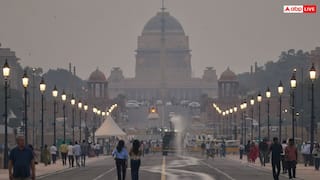What Is The Origin Of Earth's Oxygen? New Study Gives Answers
Subduction, a phenomenon in which an oceanic plate slides beneath a continental plate, could have led to formation of free oxygen, according to a new study.

Have you ever wondered what the origin of Earth's oxygen is? A new study published in the journal Nature Geoscience has found some clues to solving this mystery. Earth's early oxygen originated from a tectonic source through the movement and destruction of Earth's crust, according to the study.
Oxygen was almost absent on Earth in the Neoarchean era, which dates back to 2.8 to 2.5 billion years ago. Now, 21 per cent of the blue planet's atmosphere consists of oxygen, the molecule without which life is not possible.
During the Archean eon, about 2.5 to four billion years ago, Earth was a water-world, covered in green oceans. According to a report by The Conversation, Earth was shrouded in a methane haze at that time, and completely lacked multicellular life.
What is subduction?
The dominant tectonic activity on modern Earth is called plate tectonics. Subduction is a phenomenon in which the oceanic crust, the outermost layer of Earth under the oceans, sinks into Earth's mantle. An oceanic plate runs into a continental plate and slides beneath it.
The mantle is the area between Earth's crust and core. The oceanic crust sinks into Earth's mantle at points of convergence called subduction zones. The report said there is considerable debate over whether plate tectonics operated back in the Archean era, which represents one-third of Earth's history.
How are oxidised magmas formed?
Modern subduction zones are associated with oxidised magmas. The study said that oxidised, sulphur-rich magmas formed in subduction zones could have influenced the evolution of oceans and Earth's atmosphere in the Neoarchean period.
When oxidised sediments and bottom waters are introduced into Earth's mantle, oxidised magmas are formed. These bottom waters are cold and dense, and together with oxidised sediments, lead to the formation of magmas with high oxygen and water content.
The study aimed to test whether the absence of oxidised materials in Archean bottom waters and sediments could prevent the formation of oxidised magmas.
Since oxidised magmas have been identified in Neoarchean magmatic rocks, it suggests that subduction and plate tectonics could have occurred 2.7 billion years ago.
How the study was conducted
The researchers collected samples of granitoid rocks about 2,750 to 2,670 million years old, from across the Abitibi-Wawa subprovince of the Superior Province. The Superior Province is the largest preserved Archean continent stretching over 2,000 kilometres from Winnipeg, Manitoba, to far-eastern Quebec. Granitoid rocks are igneous rocks composed mostly of minerals such as quartz, alkali feldspar and plagioclase. Using these samples, the researchers investigated the level of oxidation of magmas generated across the Neoarchean era.
Magmatic rocks are formed through the cooling and crystallisation of magma or lava. It is challenging to measure the oxidation state of these magmatic rocks. Later deformation, burial or heating may have modified these rocks following crystallisation.
Why did researchers choose mineral apatite?
The researchers analysed the mineral apatite which is present in the zircon crystals of the rocks, the report said. The reason they chose zircon crystals is that these structures can withstand the intense temperatures and pressures of the post-crystallisation events. As a result, these minerals are likely to have been retained in their pristine form. These minerals also retain clues about the environments in which they were originally formed and can also help the researchers determine the age of the rocks.
Small apatite crystals that are less than 30 micrometres wide and contain sulphur. One can determine whether the apatite grew from an oxidised magma by measuring the amount of sulphur in the apatite.
Study found sulphur ions in the rocks
The original Archean magma's oxygen fugacity, which is an equivalent of the partial pressure of oxygen in a particular environment, was measured using a specialised technique. In other words, the researchers measured the amount of free oxygen in the Archean magma.
Magma sulphur content, which was initially zero, increased to 2,000 parts per million around 2,705 million years ago, indicating the fact that magmas had become more sulphur-rich, according to the study. Also, there was a predominance of S6+ in the apatite. S6+ is a type of sulphur ion, and its presence suggests that the sulphur was from an oxidised source.
Did the lack of dissolved oxygen in Archean ocean reservoirs prevent the formation of oxidised magmas?
Therefore, the findings suggest that oxidised magmas formed in the Neoarchean era 2.7 billion years ago. Also, the lack of dissolved oxygen in the Archean ocean reservoirs did not prevent the formation of sulphur-rich, oxidised magmas in the subduction zones.
Subduction could have generated free oxygen
The report said that the oxygen in the oxidised magmas must have come from another source, and was ultimately released into the atmosphere during volcanic eruptions.
Earlier, it was believed that the possibility of Archean magmas being oxidised is unlikely, because ocean water and ocean floor rocks were not oxidised.
According to the report, the occurrence of magmas suggests that subduction, which causes ocean water to reach hundreds of kilometres into Earth, generates free oxygen. As a result, the overlying mantle is oxidised.
Therefore, the study concluded that Archean subduction could have been an unforeseen factor in the oxygenation of Earth. The fact that Earth is the only place in the solar system with plate tectonics and active subduction could explain why it is the only planet where life could thrive.






































